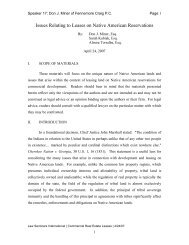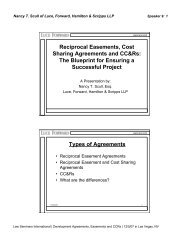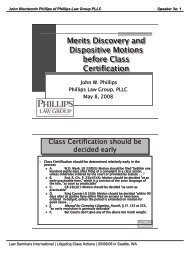LSI 2010 Real Estate Joint Ventures conference materials.pdf
LSI 2010 Real Estate Joint Ventures conference materials.pdf
LSI 2010 Real Estate Joint Ventures conference materials.pdf
You also want an ePaper? Increase the reach of your titles
YUMPU automatically turns print PDFs into web optimized ePapers that Google loves.
Brian Todd of Davis Wright Tremaine LLP<br />
Andrew H. Zuccotti of K&L Gates LLP<br />
its (some would say “illusion of” 3 ) simplicity. A draftsman can insert the target<br />
allocation provision into any operating agreement he drafts. He can exclude tax lawyers<br />
completely from the drafting process. He can save the client money and (some would<br />
say) headaches. The liquidation-by-tiers-with-target-allocations method is, in our view,<br />
more likely than the liquidation-by-capital-account method to give rise to capital shifts<br />
among the members of an LLC or the partners of a partnership, particularly in situations<br />
involving preferred returns. By its nature the liquidation-by-tiers method directs<br />
available cash be distributed in tiers. This may move one member’s capital contribution<br />
to another, senior member. (The federal income tax consequences of internal capital<br />
shifts in an LLC are not well understood by practitioners.)<br />
But this (apparent) simplicity comes at a cost, i.e., it is difficult to predict how<br />
profit and losses will be allocated. This may be a reason why accountants typically prefer<br />
the liquidation-by-capital-accounts method. And, given new Code Section 6694, which<br />
imposes penalties on “return preparers” who take a position on a return and do not have<br />
“a reasonable belief that the position would more likely than not be sustained on the<br />
merits,” it seems likely that the accountants’ preference for greater predictability will<br />
only increase. Furthermore, this lack of predictability probably makes it even more<br />
appropriate to include in the operating agreement a provision for distributions to pay tax<br />
on allocations of income.<br />
The best answer we can give to the question of which method to use in drafting<br />
LLC and partnership agreements is that it depends on the circumstances. If one of the<br />
members is a tax exempt plan or a charity, the liquidation-by-capital-accounts method<br />
seems clearly preferable because of Sections 168(h) and 514(c)(9)(E). If the business<br />
deal includes a flip-flop as a function of an internal rate of return calculation, the<br />
liquidation-by-tiers-with-target-allocations method is preferable because it is difficult to<br />
draft a flip-flop which is a function of an IRR – a cash return concept – using the<br />
liquidation-by-capital-accounts method.<br />
C. Potential Pitfalls: Drafting Issues to Watch For.<br />
Two recent cases illustrate the dangers of trying to draft an LLC agreement<br />
without input from tax counsel.<br />
1. Imprimis Investors, LLC. v. U.S., ___F.3d___ (Cl. Ct. 2008); 102<br />
AFTR2d 2008 5727.<br />
The LLC Agreement provided for a “waterfall” of allocations of net profits and<br />
net losses and then, after such waterfall, 20% of net profits and net losses would be<br />
allocated to one member, Insight. If the net profits consisted of “items of ordinary<br />
income,” then Insight was to receive a special gross income allocation of such “ordinary<br />
income” items equal to the amount Insight would otherwise receive with the remainder to<br />
be allocated to the other members. If the amount of ordinary income allocated to Insight<br />
Speaker 11: 7<br />
Speaker 12: 7<br />
3 Cuff, “Working with Target Allocation Provisions: Idiot-Proof or Drafting for Idiots?” (Pre-publication<br />
draft) (2008). Mr. Cuff sets forth a series of examples arguing that “the perceived simplicity of the target<br />
allocation provision is considerably overstated.<br />
DWT 12372832v1 0053770-000001<br />
Law Seminars International | <strong>Real</strong> <strong>Estate</strong> <strong>Joint</strong> <strong>Ventures</strong> and Funds | 02/08/10 in Seattle, WA
















